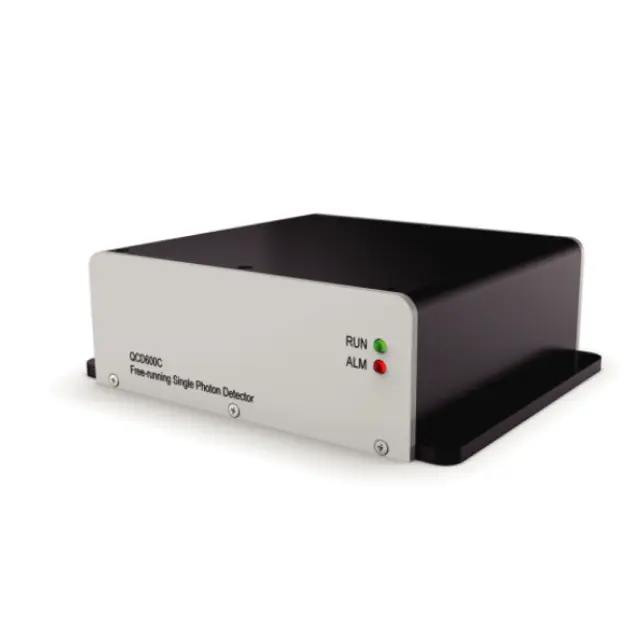Single-photon detectors offer the highest optical detection sensitivity, and their integration into LiDAR (Light Detection and Ranging) systems significantly enhances the overall performance of the system. Near-infrared light in the second near-infrared window (1.0–1.7 μm) offers advantages such as high atmospheric transmittance, weak scattering, and minimal solar background radiation. These characteristics make it an ideal wavelength range for atmospheric remote sensing and 3D imaging in LiDAR systems. Near-infrared single-photon detection technologies primarily include superconducting nanowire single-photon detectors, up-conversion single-photon detectors, and InGaAs/InP single-photon detectors. Among them, InGaAs/InP single-photon detectors are the best choice for practical 1.5 μm LiDAR systems due to their small size, low cost, ease of system integration, and excellent overall performance.
The QCD600 series uses NFAD devices to implement the basic circuit design for free-running single-photon detection, as shown in Figure 1.

Due to the extremely short avalanche time of NFAD devices (in the hundreds of picoseconds), the initial avalanche signal amplitude is only 1-2 mV. By amplifying the avalanche signal by 40 dB through a cascade of low-noise amplifiers (LNA), the amplitude is raised to 100-200 mV. The signal is then processed by a discriminator (Disc) to convert it into a digital signal, which is sent to a Field Programmable Gate Array (FPGA) for further processing. NFAD device performance is highly sensitive to temperature, and cooling is typically used to reduce dark count rates. However, cooling also increases the carrier lifetime after avalanche, leading to a higher after-pulse probability. After each avalanche event is detected, the FPGA actively sets an adjustable dead time (Hold-off) to effectively suppress the after-pulse effect, albeit at the cost of a reduced saturation count rate. The dead-time signal output from the FPGA is typically at 3.3 V, and it is amplified to over 6 V via an operational amplifier (OPA) to meet the requirement that the NFAD’s reverse bias is below the avalanche breakdown voltage when the over-voltage is close to 5 V.
When the dead-time signal is applied to the NFAD anode, due to the capacitive nature of the NFAD device, sharp differential response signals appear at the NFAD cathode, particularly negative differential signals in the trailing edge that coincide with the avalanche signal direction. To prevent misidentification, the FPGA outputs a latch signal, which is phase-locked and slightly longer than the dead-time signal, to the discriminator with latch functionality, thereby locking the discriminator during the appearance of the differential signal and filtering out its effects.
Bias Control and Bias Current Detection
Bias voltage directly determines the performance characteristics of the single-photon detector, and its stability is crucial. Since the avalanche breakdown voltage of NFAD devices is typically in the range of 50-80 V, a DC/DC boost chip (LT3482) is used, which can output a maximum voltage of 90 V and features a current mirror output pin for monitoring the bias current and providing strong light protection. The circuit principle for bias control and bias current detection is shown in Figure 2.

Cooling Temperature Control
Temperature is another decisive factor affecting the performance of single-photon detectors. The QCD600 series NFAD device uses a TO-46 package with fiber coupling. It is designed with a clamping tube and cooling box to provide cooling using a thermoelectric cooler (TEC). At an ambient temperature of 30°C, the NFAD device can be cooled to as low as -50°C, effectively suppressing dark counts.
TDC Function
In LiDAR systems, the measurement of photon flight time is crucial, as the precision of time measurement directly determines the distance resolution of the LiDAR. By integrating high-precision TDC (Time-to-Digital Converter) functionality into the detector, the overall system integration and performance of LiDAR systems can be significantly enhanced. The QCD600 series detectors feature an external trigger signal input interface. After the signal is input, it is processed by a discriminator and sent to the FPGA as the Start signal for TDC, while the detection signal inside the detector is directly sent to the FPGA as the Stop signal. Using the clock interpolation technique of the carry delay chain in the FPGA, coarse time measurement with a 10 ns resolution and 100 μs range is achieved using clock counting, while fine time measurement is achieved with a minimum delay of 100 ps using the carry chain.
After-Pulse Correction and Counting Rate Correction Algorithm
Due to the relatively high impurity and defect concentration in InGaAs/InP single-photon detectors, the after-pulse effect is prominent. Therefore, dead time is added to suppress this effect. In single-photon LiDAR applications requiring high dynamic range, after-pulse and dead time lead to distortion in the radar echo signal, requiring post-processing algorithms to correct the signal distribution. The probability distribution of after-pulse counts following a single avalanche signal can be calculated during calibration by inputting narrow pulse light, using the TDC’s time-count distribution, where i represents the time bin index on the horizontal axis of the time-count distribution.
The QCD600 series detectors include a microcontroller unit (MCU) that uses the above algorithm for after-pulse correction and counting rate correction on TDC data. The FPGA transmits real-time TDC data from RAM to the MCU, which outputs the corrected data via the USB interface, enabling real-time data post-processing.
Application in LiDAR
Replacing traditional photodetectors with single-photon detectors in LiDAR systems can significantly enhance detection range and resolution. Thanks to its multimode fiber coupling interface, integrated TDC functionality, and real-time after-pulse and counting rate correction algorithms, the QCD600 series detectors have been successfully applied in 1550 nm atmospheric aerosol LiDAR systems, greatly improving system integration and reducing costs. Figure 8 showcases a miniaturized LiDAR product using the QCD600 series single-photon detectors from Guoyao Quantum Radar Technology Co., Ltd. This system requires only 75 μJ of single-pulse energy, achieving a maximum detection range of 15 km with a distance resolution of less than 30 m, operating in an environment temperature range of -25°C to 40°C. In contrast, traditional commercial aerosol LiDAR systems struggle to achieve detection ranges beyond 10 km.
Conclusion
The QCD600 series miniaturized free-running InGaAs/InP single-photon detectors provide a compact, high-efficiency, low-noise, and low-timing-jitter single-photon detection solution for LiDAR systems. The future development of free-running single-photon detectors will focus on even more compact designs with integrated cooling technologies and ultra-low noise using deep cooling techniques, providing stronger technical support for applications such as LiDAR, Quantum Key Distribution (QKD), and more.






